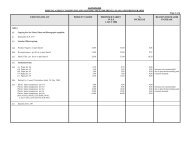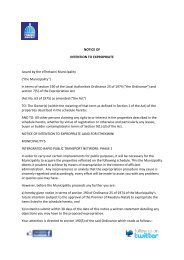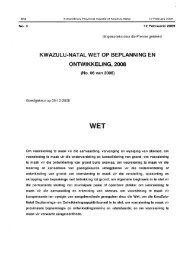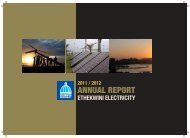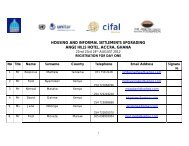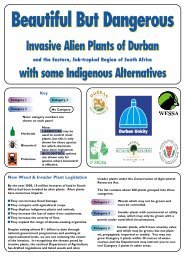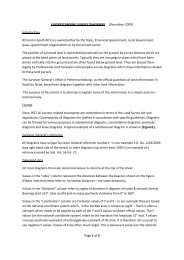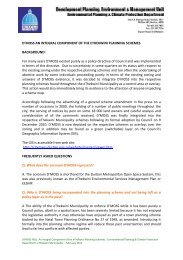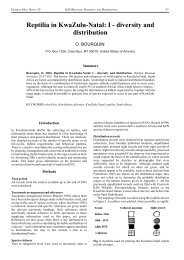Mullin, S. K., Taylor, P. J. & Pillay, N. 2004. Skull size and ... - Durban
Mullin, S. K., Taylor, P. J. & Pillay, N. 2004. Skull size and ... - Durban
Mullin, S. K., Taylor, P. J. & Pillay, N. 2004. Skull size and ... - Durban
Create successful ePaper yourself
Turn your PDF publications into a flip-book with our unique Google optimized e-Paper software.
MULLIN_08 13/08/04 12:45 Page 31<br />
D. griseifrons <strong>and</strong> most distinct from those of<br />
D. nudipes, D. montanus <strong>and</strong> D. longipilosus.<br />
REMARKS. — Although univariate results (ANOVA)<br />
do not show a difference between D. incomtus from<br />
the KwaZulu-Natal Province <strong>and</strong> specimens from the<br />
Limpopo <strong>and</strong> Mpumalanga Provinces (referred to here<br />
as D. robertsii), multivariate results <strong>and</strong> genetic data<br />
(<strong>Mullin</strong> et al. 2002) unequivocally show D. incomtus<br />
<strong>and</strong> D. robertsii as separate.<br />
Dasymys longipilosus Eisentraut, 1963.<br />
Die Wirbeltiere des Kammerungebirges: 132.<br />
TYPE LOCALITY. — Musaka Hut, southern slope of<br />
Mount Cameroon, 2200 m, Cameroon (SMNS).<br />
SPECIMENS EXAMINED. — Cameroon (Mount Cameroon).<br />
DIAGNOSIS. — This species has dark pelage <strong>and</strong> a short<br />
tail, although not as dark or short as seen in D. montanus.<br />
Distinguishing features include a small hind<br />
foot <strong>and</strong> a small total body length in addition to a<br />
small condylobasal length, upper toothrow length,<br />
internal diameter of the zygomatic arch, greatest<br />
m<strong>and</strong>ible length <strong>and</strong> m<strong>and</strong>ibular toothrow length.<br />
This species has a skull similar to D. medius <strong>and</strong><br />
D. foxi <strong>and</strong> its small <strong>size</strong> makes it particularly distinct<br />
from D. nudipes, D. capensis, D. griseifrons <strong>and</strong><br />
D. shortridgei.<br />
REMARKS. — Dasymys longipilosus was represented by a<br />
small sample <strong>size</strong> in this study. More individuals<br />
should be examined before it is erected as a separate<br />
species. Dasymys longipilosus is restricted to high altitudes<br />
(> 2000m) <strong>and</strong> is only known from Mount<br />
Cameroon.<br />
Dasymys medius Thomas, 1906.<br />
Annals <strong>and</strong> Magazines of Natural History series 7 18:<br />
143.<br />
TYPE LOCALITY. — Toro, Mubuku Valley, E. Ruwenzori,<br />
Ug<strong>and</strong>a (NHM).<br />
SPECIMENS EXAMINED. — Burundi, eastern Democratic<br />
Republic of Congo (Buhengeri, Kahungu,<br />
Kalehe, Medje, Lubero, Lushala, Medje, Muganzo,<br />
Rutshuru), Kenya, Rw<strong>and</strong>a <strong>and</strong> Ug<strong>and</strong>a (all localities<br />
MAMMALIA • 2004 • 68 (2)<br />
REMARKS. — Dasymys medius does not appear to be<br />
part of a species complex. It is somewhat surprising<br />
that this material was not more similar to material<br />
from Tanzania or Malawi, but perhaps a future study<br />
including material from these two countries (<strong>and</strong> particularly<br />
from northern Tanzania) would show otherwise.<br />
Dasymys montanus Thomas, 1906<br />
Annuals <strong>and</strong> Magazines of Natural History, series 7 18:<br />
143.<br />
TYPE LOCALITY. — Toro, Mubuku Valley, eastern<br />
Ruwenzori Mountains, 12,5000 ft, Ug<strong>and</strong>a (NHM).<br />
SPECIMENS EXAMINED. — Ug<strong>and</strong>a (Ruwenzori<br />
Mountains at high altitudes only).<br />
DIAGNOSIS. — Dasymys montanus has a small <strong>size</strong><br />
overall (both in terms of cranial <strong>and</strong> external measurements).<br />
Distinct characteristics include dark pelage<br />
<strong>and</strong> a short tail (head-body/tail ratio) in addition to<br />
small cranial features (greatest skull length, upper<br />
zygomatic arch width, zygomatic plate width, greatest<br />
m<strong>and</strong>ible length <strong>and</strong> greatest height of the skull). The<br />
skull of D. montanus is most similar to that of<br />
D. medius <strong>and</strong> although its skull does not appear to be<br />
similar to many of the other species, it is most distinct<br />
from those of D. nudipes, D. capensis <strong>and</strong> D. griseifrons.<br />
P R O O F<br />
except the single locality representing D. montanus).<br />
SYNONYMS. — Dasymys incomtus helukus Heller, 1910:<br />
Smithsonian Miscellaneous Collections 54: 2. Sirgoit,<br />
Guas Ngishu Plateau, Kenya. Dasymys incomtus nigridius<br />
Hollister, 1916: Smithsonian Miscellaneous Collections<br />
10: 2. Naivasha, Kenya. Dasymys incomtus orthos<br />
Heller, 1911: Smithsonian Miscellaneous Collections 56:<br />
13. Butiaba, Albert Nyanza, Ug<strong>and</strong>a. Dasymys incomtus<br />
savannus Heller, 1911: Smithsonian Miscellaneous<br />
Collections 17: 14. Fort Hall, Kenya. Dasymys incomtus<br />
shawi Kershaw, 1924: Annual Magazine of Natural<br />
History 9: 25. Mount Baginzi, Bahr-el-Ghazal, Sudan.<br />
DIAGNOSIS. — Dasymys medius is distinct in terms of<br />
its small upper toothrow length <strong>and</strong> small upper zygomatic<br />
arch width. The skull of D. medius was most<br />
similar to those of D. foxi <strong>and</strong> D. rufulus. Dasymys<br />
medius was most distinct from D. nudipes <strong>and</strong><br />
D. capensis.<br />
African Dasymys systematics<br />
FIG. 8. – Map of localities used in this study (provided in Table 1).<br />
, rufulus complex (including D. rufulus from West Africa <strong>and</strong><br />
material from CAR, Cameroon, northern Angola, Zambia,<br />
Tanzania, Malawi <strong>and</strong> Mozambique); 〈, D. foxi, , D. cf. griseifrons;<br />
?, unknown; ⊃, D. cf. longipilosus; σ, D. cf. medius; π,<br />
D. montanus; υ, D. nudipes; ρ, D. cf. shortridgei; , D. incomtus;<br />
?, D. cf. robertsii; ÷, D. cf. capensis.<br />
31


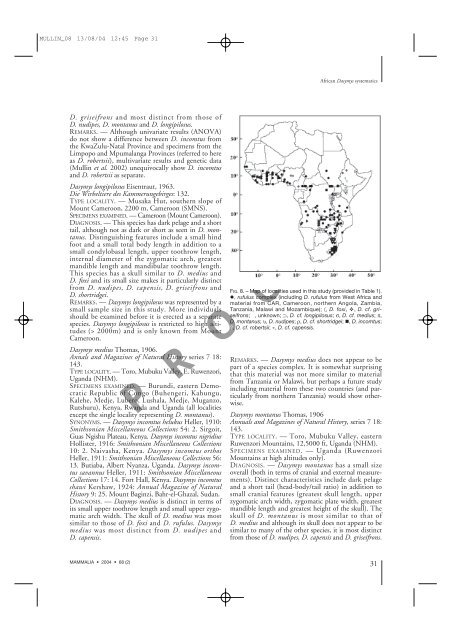
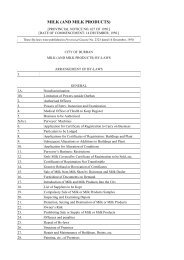
![INK Environmental Sustainability Booklet [19 MB] - Durban](https://img.yumpu.com/22025104/1/190x136/ink-environmental-sustainability-booklet-19-mb-durban.jpg?quality=85)

